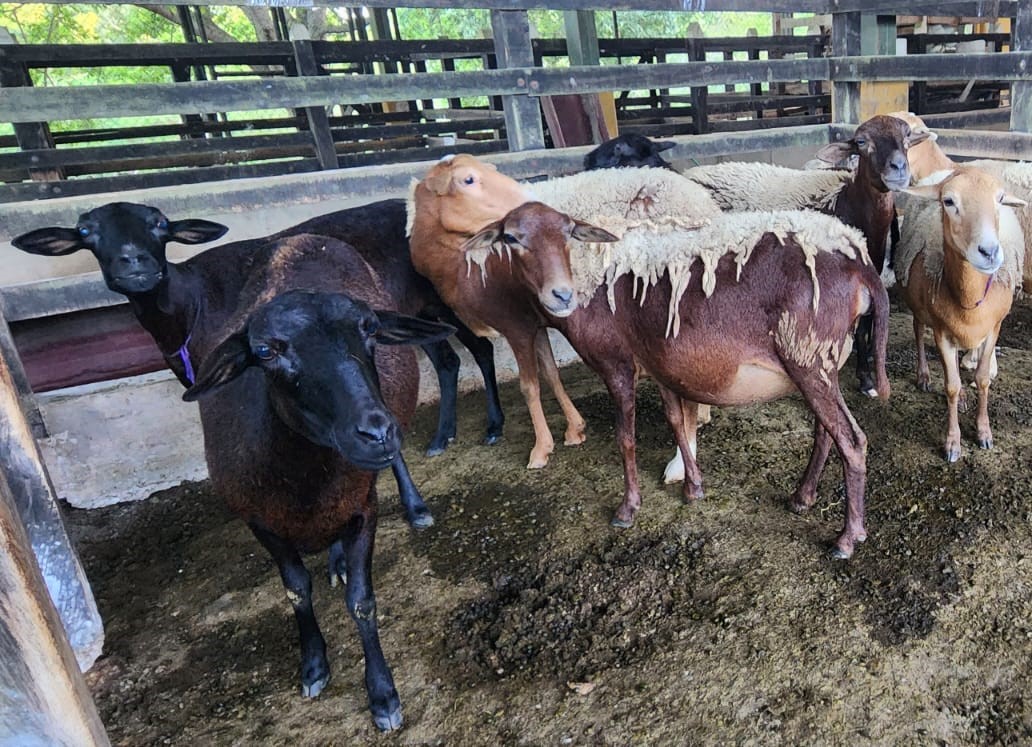Estimation of the growth curve in Colombian sheep using the Richards model
Estimación de la curva de crecimiento en ovinos de pelo colombiano mediante la utilización del modelo Richards


This work is licensed under a Creative Commons Attribution-NonCommercial-ShareAlike 4.0 International License.
Show authors biography
Objective. To describe growth in Colombian hair sheep (OPC) using the Richards model. Materials and methods. A total of 2086 records were obtained from weighing every 30 days in OPC sheep from birth to slaughter and weaning at 90 days. In addition, the sex (S), type of lambing (TP) and time of birth (Eponac) of the animals were considered. The data were analyzed with the Richards model using the NLIN procedure of SAS. Results. The asymptotic weight estimation indicated by parameter A for males was 7.8 kg higher than that of females; in the TP, this same parameter indicated a 22% superiority between single and multiple births; finally, in the Eponac variable, the best weight values corresponded to the rainy season with 5 kg more than the animals born in the dry season. For the K parameter, the reference values oscillate between 0.001 and 0.004 in the variables S, TP and Eponac; as well as the correlation between the A and K parameters, the values are between -0.98 and -0.99 in all the variables studied. Conclusions. The Richards model explained the development of the animals and allowed observing the effect of the variables S, TP and Eponac, evidencing in each of these a slow growth, but with high weights at maturity.
Article visits 546 | PDF visits
Downloads
- Simanca J, Vergara O, Moris B. Description of growth in sheep creole (Ovis aries) in two populations from Córdoba, Colombia. Rev MVZ Córdoba. 2017; 22(3):6310-6319. https://doi.org/10.21897/rmvz.1135
- Instituto Colombiano Agropecuario - ICA [Internet]. [citado 6 de diciembre de 2021]. Disponible en: https://www.ica.gov.co/areas/pecuaria/servicios/epidemiologia-veterinaria/censos-2016/censo-2018.aspx
- Noriega J, Hernández D, Bustamante M, Alvarez L, Ariza M, Vergara O. Polymorphisms of candidate genes to growth in two populations of Colombian Creole sheep. Indian J Sci Tech. 2018; 11(46):1-9. https://10.17485/ijst/2018/v11i46/132587
- Iqbal F, Waheed A, Zil-e-Huma, Faraz A. Nonlinear Growth Functions for Body Weight of Thalli Sheep using Bayesian Inference. Pak J Zool. 2019; 51(4):1421-28. http://dx.doi.org/10.17582/journal.pjz/2019.51.4.1421.1428
- Kucukonder H, Demirarslan PC, Alkan S, Özgür BB. Curve Fitting with Nonlinear Regression and Grey Prediction Model of Broiler Growth in Chickens. Pak J Zool. 2020; 52(1):347-54. https://dx.doi.org/10.17582/journal.pjz/2020.52.1.347.354
- Richards FJ. A Flexible growth function for empirical use. J Exp Bot. 1959; 10(2):290-301. https://doi.org/10.1093/jxb/10.2.290
- Kopuzlu S, Sezgin E, Esenbuga N, Bilgin OC. Estimation of growth curve characteristics of Hemsin male and female sheep. J Appl Anim Res. 2014; 42(2):228-232. https://doi.org/10.1080/09712119.2013.842479
- Hossein-Zadeh G. Modeling the growth curve of Iranian Shall sheep using non-linear growth models. Small Rumin Res. 2015; 130:60-66. https://doi.org/10.1016/j.smallrumres.2015.07.014
- Lenis-Valencia, C. P., Molina, E. J., & Álvarez-Franco, L. A. Productividad y curvas de crecimiento usando modelos no lineales en un cruce de ovino de pelo colombiano x pelibuey. Revista U.D.C.A Actualidad & Divulgación Científica. 2022; 25(2). https://doi.org/10.31910/rudca.v25.n2.2022.1853
- Nimase RG, Kandalkar YB, Bangar YC. Non-linear modeling for estimation of growth curve parameters in Madgyal sheep. J Entomol Zool Stud. 2018; 6(2):463-465. https://www.entomoljournal.com/archives/2018/vol6issue2/PartG/6-1-202-897.pdf
- Balan C, Kathiravan G, Thirunavukkarasu M, Jeichitra V. Non-linear growth modelling in Mecheri breed of sheep. J Entomol Zool Stud. 2017; 5(5):2005-2008. https://www.entomoljournal.com/archives/2017/vol5issue5/PartZ/5-5-161-663.pdf
- Ghavi Hossein-Zadeh, N. Modeling the growth curve of Iranian Shall sheep using non-linear growth models. Small Ruminant Research. 2015; 130, 60-66. https://doi.org/10.1016/j.smallrumres.2015.07.014
- Bahreini BM, Aslaminejad AA, Sharifi AR, Simianer H. Comparison of mathematical models for describing the growth of Baluchi sheep. J Agri Sci Tech. 2014; 16(14):57-68. https://www.sid.ir/en/journal/ViewPaper.aspx?id=354455
- Tariq MM, Iqbal F, Eyduran E, Bajwa MA, Huma ZE, Waheed A. Comparison of non-linear functions to describe the growth in Mengali sheep breed of Balochistan. Pak J Zool. 2013; 45(3):661-665. http://zsp.com.pk/pdf45/661-665%20_11_%20PJZ-1185-12%2021-5-13%20revised_corrected_copy.pdf
- Teixeira MC, Villarroel AB, Pereira ES, de Oliveira SMP, Albuquerque ÍA, Mizubuti IY. Curva de crescimento de cordeiros oriundos de três sistemas de produção na Região Nordeste do Brasil. Semina Ciênc Agrár. 2012; 33(5):2011-2018. http://dx.doi.org/10.5433/1679-0359.2012v33n5p2011
- Cuello M, Moreno J, Aguilar F, Baracaldo A, Atuesta-Bustos J. Factores no genéticos en el crecimiento predestete de corderos biotipo lana en el trópico de altura colombiano. Rev Investig Vet Perú. 2019; 30(1):231–239. https://doi.org/10.15381/rivep.v30i1.14902
- Yilmaz A, Karakus F, Bingöl M, Kaki B, Ser G. Effects of some factors on growth of lambs and the determination of growth curve models. Indian J Anim Res. 2018; 52(9):1257-1262. http://doi.org/10.18805/ijar.B-815
- Gabr AA, Shalaby NA, Ahmed ME. Effect of ewe born type, growth rate and weight at conception on the ewe subsequent productivity of Rahmani sheep. Asian J Anim Vet Adv. 2016; 11:732-736. http://doi.org/10.3923/ajava.2016.732.736
- Gemiyo D, Abebe G, Ganga G, Tera A, Gemeda BS. Early growth and survival rates of crossbred lambs (Dorper x indigenous) under semi-intensive management at Areka, Southern Ethiopia: Effects of non-genetic factors. Afr J Agric Res. 2017; 12(23):2008-2016. https://doi.org/10.5897/AJAR2017.12280
- Vergara-Garay O, Llorente-Martínez E, Ramos-Caro L, Bustamante-Yánez M, Simanca-Sotelo JC. Descripción del crecimiento en ovinos criollos utilizando el modelo Brody. Orinoquia. 2016; 20(2):34-39. https://doi.org/10.22579/20112629.351
- Faraz A, Younas M, Waheed A, Yaqoob M, Ishaq K. Growth performance and hair mineral status of Marecha (Camelus dromedarius) calves reared under different management systems. Pak J Zool. 2019; 51:503-509. http://dx.doi.org/10.17582/journal.pjz/2019.51.2.503.509
- Miller B, Selevsek N, Grossmann J, Kilminster T, Scanlon T, Daniels M, et al. Ovine liver proteome: Assessing mechanisms of seasonal weight loss tolerance between Merino and Damara sheep. J Proteomics. 2019; 191:180-190. https://doi.org/10.1016/j.jprot.2018.02.018























